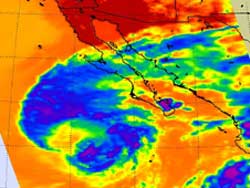NASA Sees a Western Weakness in Tropical Storm Miriam

This infrared image was created from AIRS data of Tropical Storm Miriam on Sept. 26 at 2047 UTC off the coast of Baja California. Strongest thunderstorms with very cold cloud top temperatures appear in purple surrounding north, east and south of the center of circulation. Credit: NASA JPL/Ed Olsen<br>
The Atmospheric Infrared Sounder (AIRS) instrument that flies aboard NASA's Aqua satellite captured infrared data on Tropical Storm Miriam on Sept. 26 at 2047 UTC, when it was off the coast of Baja California.
Strongest thunderstorms with very cold cloud top temperatures appear to surround north, east and south of the center of circulation. By Sept. 27, only the northern quadrant of the storm appeared to have those strong thunderstorms.
Miriam appears to be weakening quickly because of strong wind shear and cooler waters.
At 11 a.m. EDT on Sept. 27, Miriam's maximum sustained winds had decreased to near 40 mph (65 kmh) and further weakening is expected. The National Hurricane Center noted that Miriam could become a remnant low later today or tomorrow, Sept. 28.
The center of Tropical Storm Miriam was located near latitude 22.2 north and longitude 116.3 west. Miriam is moving northwest near 6 mph (9 kmh) and is expected to turn west.
Regardless of the weakening condition of the storm, Miriam is still generating dangerous ocean swells along the south and west coasts of the southern and central Baja peninsula today but those will begin to gradually subside by Sept. 28.
Text credit: Rob Gutro
NASA's Goddard Space Flight Center, Greenbelt, Md.
Media Contact
All latest news from the category: Earth Sciences
Earth Sciences (also referred to as Geosciences), which deals with basic issues surrounding our planet, plays a vital role in the area of energy and raw materials supply.
Earth Sciences comprises subjects such as geology, geography, geological informatics, paleontology, mineralogy, petrography, crystallography, geophysics, geodesy, glaciology, cartography, photogrammetry, meteorology and seismology, early-warning systems, earthquake research and polar research.
Newest articles

Trotting robots reveal emergence of animal gait transitions
A four-legged robot trained with machine learning by EPFL researchers has learned to avoid falls by spontaneously switching between walking, trotting, and pronking – a milestone for roboticists as well…

Innovation promises to prevent power pole-top fires
Engineers in Australia have found a new way to make power-pole insulators resistant to fire and electrical sparking, promising to prevent dangerous pole-top fires and reduce blackouts. Pole-top fires pose…

Possible alternative to antibiotics produced by bacteria
Antibacterial substance from staphylococci discovered with new mechanism of action against natural competitors. Many bacteria produce substances to gain an advantage over competitors in their highly competitive natural environment. Researchers…





















